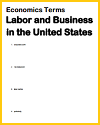Labor and Business in the United States |
 |
 |
|||||||||
| Types of Businesses Blank Chart | Labor and Business Vocabulary Terms Sheet |
|
Studying economics involves learning a wide range of terms and concepts. Here are some of the most important terms to know when studying economics. Comparative Advantage: The principle that countries or individuals should specialize in producing the goods or services they can produce most efficiently and trade for others. Deadweight Loss: The loss of economic efficiency that occurs when the equilibrium quantity and price of a good or service are not at their most efficient levels. Deflation: The opposite of inflation, where the general price level of goods and services decreases over time. Economies of Scale: The cost advantages that a business can achieve by producing larger quantities of a product. Elasticity: A measure of the responsiveness of quantity demanded or supplied to changes in price or income. Externalities: Unintended consequences of economic activities that affect third parties who are not involved in the transaction. Fiscal Policy: Government policies related to taxation, spending, and borrowing to influence economic conditions. Globalization: The process of increased interconnectedness and interdependence among countries in terms of trade, investment, technology, and culture. Gross Domestic Product (GDP): The total value of all goods and services produced in a country over a specific period, often used to measure economic growth. Human Capital: The skills, knowledge, and abilities that individuals acquire through education, training, and experience, which contribute to their productivity and economic value. Income Inequality: The unequal distribution of income or wealth among individuals or households in a society. Inflation: The rate at which the general price level of goods and services rises, leading to a decrease in the purchasing power of currency. Interest Rate: The cost of borrowing money or the return on investment for saving or lending. Laissez-Faire: An economic philosophy advocating minimal government intervention in the economy, often associated with free-market capitalism. Market: The mechanism through which buyers and sellers interact to exchange goods and services. Monetary Policy: The management of a country's money supply and interest rates by its central bank to achieve economic objectives such as price stability and full employment. Monopoly: A market structure in which a single seller or producer dominates the entire market for a particular good or service. Oligopoly: A market structure in which a few large firms dominate the industry. Opportunity Cost: The cost of forgoing the next best alternative when making a decision. It represents the value of what is given up. Perfect Competition: A market structure characterized by many small firms, identical products, and ease of entry and exit. Public Goods: Goods or services that are non-excludable and non-rivalrous, meaning they are available to all and one person's consumption does not reduce their availability to others. Scarcity: The fundamental economic problem where resources are limited, but human wants and needs are unlimited. Supply and Demand: The interaction between the quantity of a good or service producers are willing to offer (supply) and the quantity consumers are willing to buy (demand). This interaction determines prices. Sustainability: The capacity to maintain or improve living standards over the long term without depleting natural resources or causing environmental harm. Utility: The satisfaction or happiness that individuals derive from consuming goods and services. These terms provide a foundation for understanding economic principles and concepts. As you delve deeper into economics, you will encounter more specialized terminology related to various subfields, such as microeconomics, macroeconomics, international economics, and more. |






